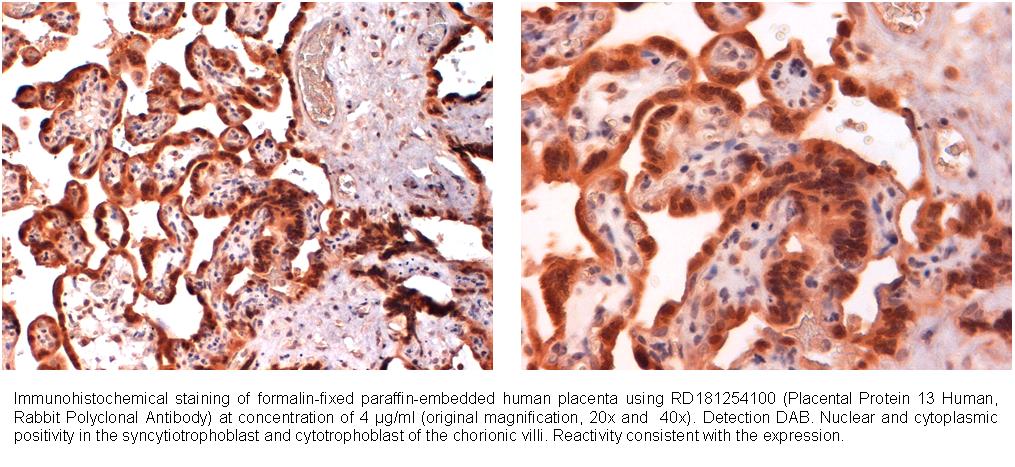Type
Polyclonal Antibody
Applications
Western blotting, ELISA, Immunohistochemistry
Antibodies Applications
Source of Antigen
E. coli
Hosts
Rabbit
Isotype
IgG
Preparation
The antibody was raised in rabbits by immunization with the recombinant Human Placental Protein 13.
Amino Acid Sequence
Recombinant Human Placental Protein 13, total 149 AA. MW: 17.36 kDa (calculated). UniProtKB acc.no. Q9UHV8. N-Terminal His-tag (10 extra AA)
MKHHHHHHASMSSLPVPYKLPVSLSVGSCVIIKGTPIHSFINDPQLQVDFYTDMDEDSDIAFRFRVHFGNHVVMNRREFGIWMLEETTDYVPFEDGKQFELCIYVHYNEYEIKVNGIRIYGFVHRIPPSFVKMVQVSRDISLTSVCVCN
Species Reactivity
Human. Not yet tested in other species.
Purification Method
Immunoaffinity chromatography on a column with immobilized recombinant Human Placental Protein 13.
Antibody Content
0.1 mg (determined by BCA method, BSA was used as a standard)
Formulation
The antibody is lyophilized in 0.05 M phosphate buffer, 0.1 M NaCl, pH 7.2.
Reconstitution
Add 0.2 ml of deionized water and let the lyophilized pellet dissolve completely. Slight turbidity may occur after reconstitution, which does not affect activity of the antibody. In this case clarify the solution by centrifugation.
Shipping
At ambient temperature. Upon receipt, store the product at the temperature recommended below.
Storage/Expiration
The lyophilized antibody remains stable and fully active until the expiry date when stored at -20°C. Aliquot the product after reconstitution to avoid repeated freezing/thawing cycles and store frozen at -80°C. Reconstituted antibody can be stored at 4°C for a limited period of time; it does not show decline in activity after one week at 4°C.
Quality Control Test
Indirect ELISA – to determine titer of the antibody
SDS PAGE – to determine purity of the antibody
BCA - to determine quantity of the antibody
Note
This product is for research use only.
Research topic
Reproduction
Summary
Placental protein 13 (PP13, Galectin 13) is the member of the beta-galactoside binding S-type galectin superfamily, whose members are important in placenta implantation and remodelling of maternal arteries. PP13 binds to beta-galactoside residues of several proteins on the cell surface, cytoskeleton and extracellular matrix, thereby generating various responses such as immune responses and influencing other functions like apoptosis and molecular recognition. PP13, which is predominantly produced by placental tissue, possesses a conserved carbohydrate binding domain, to which two proteins Annexin-II and Actin-beta bind. These proteins are considered to play a key role in placentation and maternal artery remodelling respectively. Human PP13 is a relatively small protein with 139 amino acids and is composed of two identical 16 kDa subunits held together by disulfide bonds. PP13 was first isolated from placenta and especially from the syncytiotrophoblast in 1983 by Bohn et. al. It is localized to the syncytiotrophoblast brush border membrane, and detected in maternal and cord blood. Though it is found primarily in placenta, some PP13 expression was also detected in healthy spleen, kidney and bladder tissue and in liver adenocarcinoma, neurogen tumour and malignant melanoma. The serum levels of PP13 slowly increase during a normal pregnancy but abnormally low levels of PP-13 were detected in first trimester serum samples of women subsequently developing fetal growth restriction and preeclampsia, especially in cases with early onset. Elevated serum concentrations of PP-13 have been found in the second and third trimester in women with preeclampsia, intrauterine growth restriction (IUGR) and in preterm delivery. Another study concluded that first-trimester serum levels of PP13 may serve as a suitable marker for preterm preeclampsia but are weak for the prediction of severe preeclampsia and ineffective for mild preeclampsia at term.

